(Originally published in VIVA: Jordan/UAE Leisure Magazine, February 2007.)
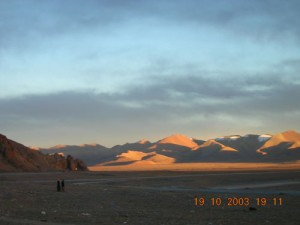 No leg room, but a partial view afforded me a glimpse of the scenic splendour which greeted me in Tibet. Mouth agape, I peered with awe out of the scratched window as snow-capped peaks succumbed to naked brown mountains, an imposing behemoth that swallowed the aircraft which the pilot deftly manoeuvred to a safe landing within the belly of the beast.
No leg room, but a partial view afforded me a glimpse of the scenic splendour which greeted me in Tibet. Mouth agape, I peered with awe out of the scratched window as snow-capped peaks succumbed to naked brown mountains, an imposing behemoth that swallowed the aircraft which the pilot deftly manoeuvred to a safe landing within the belly of the beast.
Upon disembarking, I was instantly blinded by a glaring sun that ricocheted off the pervasive mountain range. It was unexpectedly hot and my body registered confusion, having just endured several months of rainy, bone-chilling climate that seemed to shadow me throughout my mainland China excursion. I gasped for air as the lofty elevation (at 3,650 metres, Lhasa is one of the highest cities in the world) assaulted my respiratory system, a surprise despite forewarnings… Lighting a cigarette in rebellion, I drew a deep breath and promptly choked. Not so good, I realised. Altitude sickness symptoms persisted throughout the first night – insomnia, shortness of breath, headache and a dry, relentless cough – and I discovered upon awaking the next morning that my body had fully succumbed to the malady.
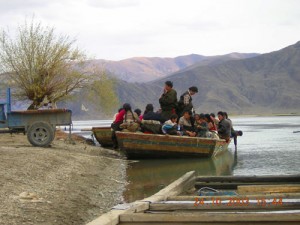 In addition to the physical lethargy, my mental facilities seemed to have also fallen victim; not exactly ‘brain freeze’, but more like my mind was languishing in suspended animation. I noted that I didn’t have the strength to explore Barkar Square, the renowned Tibetan market, which for this admitted shopaholic was not a good sign. Heeding the advice of the locals, I took it easy for a few days, allowing my body to adjust to the change in altitude and giving me time to prepare for the extraordinary impending road journey between Lhasa and Kathmandu.
In addition to the physical lethargy, my mental facilities seemed to have also fallen victim; not exactly ‘brain freeze’, but more like my mind was languishing in suspended animation. I noted that I didn’t have the strength to explore Barkar Square, the renowned Tibetan market, which for this admitted shopaholic was not a good sign. Heeding the advice of the locals, I took it easy for a few days, allowing my body to adjust to the change in altitude and giving me time to prepare for the extraordinary impending road journey between Lhasa and Kathmandu.
Often I am asked to designate my favourite of all the many remarkable places I’ve visited. And while this is an impossible task, as each destination possesses its own magic and holds indelible and distinct memories, I must acknowledge that Tibet occupies a most cherished niche. I fell in love with TAR (Tibet Autonomous Region) from the gate – actually, from within the cabin of an arriving plane.
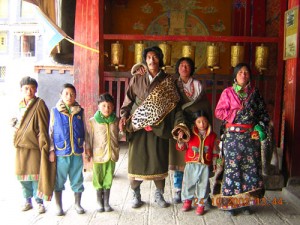 The stark dramatic terrain, all virginal white Himalayan peaks with undulating chocolate hills, the only hints of colour provided by the azure sky or sapphire lakes dotting the countryside. The vibrant regional costumes donned by the warm, gregarious people. The poignant history and resonant culture and the spiritual fervour embraced by the Tibetans despite their most celebrated maltreatment… I was consistently surprised and inspired by the faith and courage exhibited by these stalwart people, a testament to the resolve of the human spirit.
The stark dramatic terrain, all virginal white Himalayan peaks with undulating chocolate hills, the only hints of colour provided by the azure sky or sapphire lakes dotting the countryside. The vibrant regional costumes donned by the warm, gregarious people. The poignant history and resonant culture and the spiritual fervour embraced by the Tibetans despite their most celebrated maltreatment… I was consistently surprised and inspired by the faith and courage exhibited by these stalwart people, a testament to the resolve of the human spirit.
A world away from the chaos, confusion and claustrophobia which defined my overall experience in and impressions of mainland China, Tibet exuded serenity and piety. Even the hawkers in Lhasa were placid and good-natured, smiling as they tugged at my arm or playfully poked at my tattoos. An innate gentleness seemed to infuse the Tibetan nationals and, as I said, I fell in love…
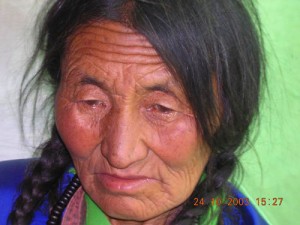 Although still sluggish, on my second day I was ready to begin surveying Lhasa, the traditional capital of Tibet from where the Dalai Lama was exiled, and the current capital of the Tibet Autonomous Region of the People’s Republic of China. Lhasa literally means ‘place of the gods’, although ancient Tibetan documents and inscriptions demonstrate that the place was first called Rasa, which means ‘courtyard place’ or ‘goat place’. Home to approximately 200,000 people, including a great number of relocated Chinese, Lhasa feels more like a large town than a small city, easy to navigate and pleasant to stroll. There is a sense of segregation, however, between the Tibetan and Chinese nationals. Barkar Square, the hub of Tibetan commercial activity and home of Jokhang Temple, the significance of which is punctuated by the presence of hordes of prostrating pilgrims, exists ironically as a Tibetan ghetto within Tibet while the once grand Potala Palace, former residence of the Dalai Lama, serves as a cavernous reminder of a fractured past.
Although still sluggish, on my second day I was ready to begin surveying Lhasa, the traditional capital of Tibet from where the Dalai Lama was exiled, and the current capital of the Tibet Autonomous Region of the People’s Republic of China. Lhasa literally means ‘place of the gods’, although ancient Tibetan documents and inscriptions demonstrate that the place was first called Rasa, which means ‘courtyard place’ or ‘goat place’. Home to approximately 200,000 people, including a great number of relocated Chinese, Lhasa feels more like a large town than a small city, easy to navigate and pleasant to stroll. There is a sense of segregation, however, between the Tibetan and Chinese nationals. Barkar Square, the hub of Tibetan commercial activity and home of Jokhang Temple, the significance of which is punctuated by the presence of hordes of prostrating pilgrims, exists ironically as a Tibetan ghetto within Tibet while the once grand Potala Palace, former residence of the Dalai Lama, serves as a cavernous reminder of a fractured past.
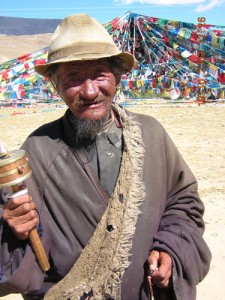 For tourists, Lhasa is a launching pad for all other points throughout the region. Although certainly not reputed as a party town, we must acknowledge that where there are travellers, there is bound to be some revelry. And as such, one evening found a group of us crashing a local club where a Michael Jackson impersonator rendered a raucous version of Thriller, and locals unabashedly danced to decades-old Western music. A karaoke bar was on the itinerary for the following evening, providing equal opportunity embarrassment where distinctions between east and west are suitably blurred as Tibetans, Chinese and foreigners alike similarly bastardised renditions of Yesterday and Hotel California. It was also my first indication of the burgeoning prostitution scene in Lhasa, a sad and inevitable result of Chinese infiltration, industrialisation and pervasive poverty in rural Tibet.
For tourists, Lhasa is a launching pad for all other points throughout the region. Although certainly not reputed as a party town, we must acknowledge that where there are travellers, there is bound to be some revelry. And as such, one evening found a group of us crashing a local club where a Michael Jackson impersonator rendered a raucous version of Thriller, and locals unabashedly danced to decades-old Western music. A karaoke bar was on the itinerary for the following evening, providing equal opportunity embarrassment where distinctions between east and west are suitably blurred as Tibetans, Chinese and foreigners alike similarly bastardised renditions of Yesterday and Hotel California. It was also my first indication of the burgeoning prostitution scene in Lhasa, a sad and inevitable result of Chinese infiltration, industrialisation and pervasive poverty in rural Tibet.
Once I started feeling stronger, I joined several other travellers for the 233-kilometre jaunt to the eminent pilgrimage site of Lake Namsto, inside which sit five holy islets said to be the incarnation of the Five Buddhas. Spectacularly beautiful, where snow-kissed mountains hug an impossibly crystalline blue lake, throngs of devotees who had caravanned from every corner of Tibet set up makeshift camps and spend their days orbiting the sacred lake. The absurdly frigid climate hindered neither their mission nor their elation. I returned after a brisk walk one day to find a woman and her infant child in our tent. The woman was crying, but as I learned, she was shedding tears of joy and appreciation after one of our crew presented her with a simple sketch of the Dalai Lama torn from a guidebook. It is illegal for locals to possess a picture of the Buddhist leader and equally illegal for tourists to bring one into the region. This was not a photo, simply a line drawing ripped from a dog-eared book, but a gift of abundance for this woman nonetheless. Another memorable moment amongst the many I experienced here.
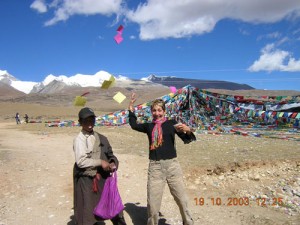 Back to Lhasa briefly to secure permits and prepare for our arduous yet elucidating six-day journey, a route famously known as the Friendship Highway. After loading our gear into the four-wheel drive, an international quartet of travellers, the driver and a guide piled into the vehicle just past dawn in the last week of October. We were cutting it close as many mountain passes would be impenetrable in a matter of weeks or perhaps days, depending on the weather. We were going high, high up onto the Himalayas, higher still to Mt Everest base camp where we would spend a freezing night at a rudimentary, unheated monastery.
Back to Lhasa briefly to secure permits and prepare for our arduous yet elucidating six-day journey, a route famously known as the Friendship Highway. After loading our gear into the four-wheel drive, an international quartet of travellers, the driver and a guide piled into the vehicle just past dawn in the last week of October. We were cutting it close as many mountain passes would be impenetrable in a matter of weeks or perhaps days, depending on the weather. We were going high, high up onto the Himalayas, higher still to Mt Everest base camp where we would spend a freezing night at a rudimentary, unheated monastery.
Day One: We visit Samye Monastery and continue on to Nagartse, at an elevation of 4,500 metres, where we encamp in a no-frills guesthouse. En route it begins to snow. Huge snowflake pellets obscure our vision and carpet the road.
Day Two: We descend slightly to 3,950 and 3,900 metres respectively as we foray to Gyantse and then Shigatze, where we again bunk down in most basic accommodations.
Day Three: We climb back up to Sakya’s 4,280 metres and level off at 4,050 metres in Shegar, our pit stop for the night.
Day Four: The highlight! Our arrival at Everest Base Camp, at 5,200 metres. Teeth-chattering cold, hot tea in a tent, several of our group opt to walk further up. A ferocious, powerful wind barely allows me to remain erect, so I stay behind. That evening, a small fire blazes in Rongphu Monastery’s kitchen around which fifteen or so hardy travellers convene. Freezing but euphoric. We’re on Mt Everest! It takes me nearly an hour to comfortably ensconce myself in my sleeping bag, shrouded as I am in layers of clothes, hats and gloves, so it is an unwelcome shock to realise that I have to go to the bathroom. Lying beneath the covers, I tried to will myself to sleep. But a persistent reminder that I have to go would deny me the pleasure of slumber. Finally and begrudgingly, I extricate myself from the man-made womb and scurry outside into the elements where I am compelled to do my business. So cold. I run back to bed and remain there for better or worse until morning, when it is still so cold. But we are at the base of Mt Everest, the fabled mountain looming majestically ahead – a once in a lifetime experience!
Day Five: Regenerated by steaming coffee, we cram back into our Jeep and head to Old Tingri, where we drop off one of our posse. And then we are three as we continue down to Zhangmu (2,300 metres), the Tibetan town bordering Nepal. There we sleep in the relative warmth of a hotel room, fuelled by bad hotel restaurant food and invigorated by the journey we had just shared.
Day Six: We walk across the Nepalese border, where the brown, white and blue of Tibet is replaced by verdant lushness. We ride the roof of a local bus to Kathmandu where my next adventure awaits.



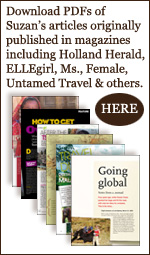
 Global Gypsy Collection ©2010 - 2011
Global Gypsy Collection ©2010 - 2011